Introduction
What level security clearance do you hold?
Are you also a District Threat Investigator?
How many years have you been a District Threat Investigator for this district? (n=82)
Approximately how much of your time is spent investigating threats in a typical week?
Did you attend the Protective Investigation Training Program held at FLETC during July and August?
How many years have you been the JSI for this district?
How many judges does your district currently provide protection for?
To whom do you offer security briefings? Check all that apply.
Approximately how many judges in your district have received a security briefing in the past 12 months?
Approximately how many judges in your district have declined a security briefing in the past 12 months?
What is the most common reason given by judges for declining a security briefing in the past 12 months? Check one.
Approximately how many judges in your district have declined to provide a Judicial Personnel Profile?
Who in your district primarily supervises protective details?
Who in your district primarily coordinates with headquarters on resource requests for protective details over 72 hours?
In April 2006, USMS headquarters issued new directives on protective details and investigations, among others. Have you had the opportunity to review the new directives?
Please tell me how much you agree or disagree with the following statement: My district generally receives threat assessments from OPI in sufficient time to assist in conducting threat investigations.
According to the new directives, OPI has 3 days to analyze expedited threats and 7 days to analyze standard threats. Is the 3-day time frame for expedited threats sufficient to assist you in conducting these types of threat investigations?
If no, what would be a sufficient timeframe for expedited threats?
Is the 7-day time frame for standard threats sufficient to assist you in conducting these types of threat investigations?
If no, what would be a sufficient timeframe for standard threats?
How useful is the Comparative Analysis score to your district in assessing threats?
Please explain your response to the previous question.
In the past 12 months, has the Comparative Analysis score caused you to… Check all that apply.
How useful is the MOSAIC score to your district in assessing threats? (n=82)
Please explain your response to the previous question.
In the past 12 months, has the MOSAIC score caused you to… Check all that apply.
Have you received any TAVISS query results from OPI in the past 12 months?
How useful are the TAVISS query results to your investigations?
Please explain your response to the previous question.
What other information does your district currently receive from OPI? Check all that apply.
How useful are the other information products from OPI we just listed to your investigations?
Please explain your response to the previous question.
What additional information do you need from OPI to better assist you in protecting the judiciary?
Aside from reporting judicial threats for assessment, what other types of judicial security information does your district provide to OPI?
Approximately how many threat investigations are currently open in your district?
Please describe any working relationships—formal or informal—that your district has established with state or local law enforcement or state courts concerning the USMS’s judicial security mission.
Does your district generally contact the U.S. Attorneys Offices’ Intelligence Research Specialists during the course of threat investigations?
Is your district aware of any state and local law enforcement or court databases that contain information to assist the USMS in threat investigations?
Does your district routinely query these databases when investigating threats?
Does your district have direct access to these databases?
Who in your district is primarily responsible for entering threat information into WIN/JDIS/JDIS? Check one.
What percent of threat cases do you estimate district personnel enter into WIN/JDIS/JDIS?
What is the most important factor that affects how quickly threat information is entered into WIN/JDIS/JDIS? Check one.
Are you aware of an initiative to expand the use of TOG for judicial security operations?
Who in your district normally requests assistance from TOG?
Has your district requested TOG assistance for judicial security at any time in the past 12 months?
If no, the district did not request TOG assistance because:
Are you aware of the Director’s recent initiative that created Rapid Deployment Teams (RDT) to assist districts in crisis situations involving judicial security?
Who in your district would request RDT assistance?
Has your district requested a Rapid Deployment Team at any time in the past 12 months?
If no, the district did not request any RDT assistance because:
Does your district have a JTTF representative?
If yes, is the representative a full-time or part-time member of the JTTF?
How much interaction or communication do you have with the JTTF representative?
How would you rate the usefulness of your district having representation on the JTTF to the judicial security mission?
How would you rate the overall usefulness of your district having representation on the JTTF?
| Response Choices | Number of Responses |
Percentage |
|---|---|---|
| Top Secret | 63 | 77 |
| Secret | 18 | 22 |
| Don’t Know | 1 | 1 |
| Total | 82 | 100% |
| Response Choices | Number of Responses |
Percentage |
|---|---|---|
| No | 35 | 43 |
| Yes | 47 | 57 |
| Total | 82 | 100% |
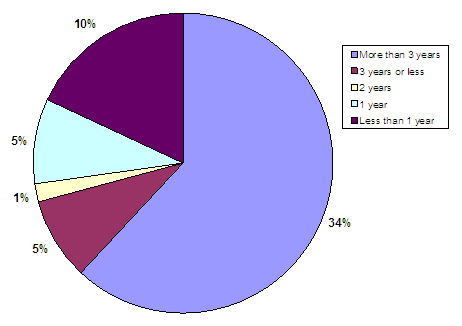
| Response Choices | Number of Responses |
Percentage |
|---|---|---|
| 75% or more | 0 | 0 |
| 50% to 75% | 1 | 1 |
| Between 25% and 50% | 3 | 4 |
| 25 % or less | 41 | 50 |
| Non-DTIs | 37 | 45 |
| Total | 82 | 100% |
| Response Choices | Number of Responses |
Percentage |
|---|---|---|
| No | 57 | 70 |
| Yes | 25 | 30 |
| Total | 82 | 100% |
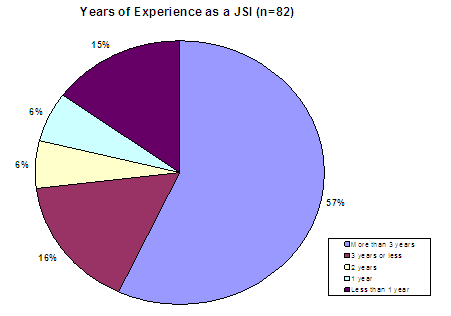
The number of judges that district reported providing protection for ranged from 3 to 125.
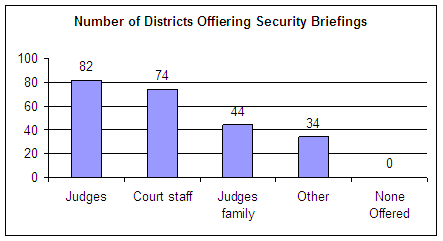
The number of judges that received a security briefing in the past 12 months ranged from 0 to 80.
The number of judges that declined a security briefing in the past 12 months ranged from 0 to 29.
| Response Choices | Number of Responses |
Percentage |
|---|---|---|
| Insufficient threat | 3 | 7 |
| No reason provided | 14 | 35 |
| No time | 10 | 25 |
| Security briefing is not useful | 2 | 6 |
| Other | 11 | 27 |
| Total | 40 | 100% |
The number of judges that declined to provide a Judicial Personnel Profile ranged from 0 to 75. On average, six judges per district declined to provide one.
Protective Details
| Response Choices | Number of Responses |
Percentage |
|---|---|---|
| US Marshal | 0 | 0 |
| Chief DUSM | 0 | 0 |
| Supervisory DUSM | 5 | 6 |
| JSI | 72 | 88 |
| Don't Know | 4 | 5 |
| Other | 1 | 1 |
| Total | 82 | 100% |
| Response Choices | Number of Responses |
Percentage |
|---|---|---|
| US Marshal | 1 | 1 |
| Chief DUSM | 8 | 11 |
| Supervisory DUSM | 2 | 2 |
| JSI | 65 | 79 |
| Don't Know | 4 | 5 |
| Other | 2 | 2 |
| Total | 82 | 100% |
Office of Protective Intelligence
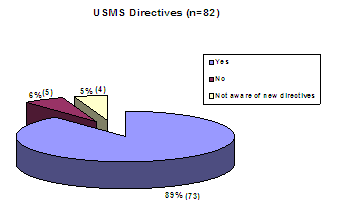
| Response Choices | Number of Responses |
Percentage |
|---|---|---|
| Strongly Agree | 23 | 28 |
| Agree | 43 | 52 |
| No opinion | 11 | 14 |
| Disagree | 4 | 5 |
| Strongly Disagree | 1 | 1 |
| Total | 82 | 100% |
| Response Choices | Number of Responses |
Percentage |
|---|---|---|
| Yes | 45 | 55 |
| No | 27 | 33 |
| Don’t Know | 10 | 12 |
| Total | 82 | 100% |
| Suggested Timeframes | Number of Responses |
Percentage |
|---|---|---|
| Less than 1 day | 1 | 4 |
| 1 day | 18 | 66 |
| 2 days | 8 | 30 |
| Total | 27 | 100% |
| Response Choices | Number of Responses |
Percentage |
|---|---|---|
| Yes | 60 | 73 |
| No | 16 | 20 |
| Don’t Know | 6 | 7 |
| Total | 82 | 100% |
| Suggested Timeframes | Number of Responses |
Percentage |
|---|---|---|
| 5 days | 7 | 44 |
| 4 days | 1 | 6 |
| 3 days | 5 | 31 |
| 2 days | 3 | 19 |
| Total | 16 | 100% |

The responses regarding the usefulness of the Comparative Analysis were grouped into 15 categories. The top five response categories were 1) views Comparative Analysis as another tool to make decisions; 2) general comment about Comparative Analysis not being useful; 3) respondents did not know how to interpret the score; 4) rely on information from the field more than Comparative Analysis score; and 5) use score to justify decisions to judges.
| Possible Actions Taken | Number of Responses |
|---|---|
| Close an investigation? | 14 |
| Re-open an investigation? | 0 |
| Enhance a protective response? | 6 |
| Discontinue a protective response? | 4 |
| Confirm the investigator’s actions? | 53 |
| Comparative Analysis score has had no impact | 5 |
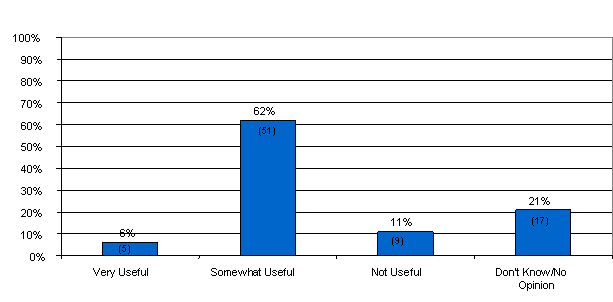
The responses regarding the usefulness of the MOSAIC were grouped into 14 categories. The top five response categories were 1) views MOSAIC as another tool to make decisions; 2) respondents did not know how to interpret the score; 3) rely on information from the field more than MOSAIC score; 4) use score to justify decisions to judges; and 5) general negative comment about MOSAIC.
| Possible Actions Taken | Number of Responses |
|---|---|
| Close an investigation? | 6 |
| Re-open an investigation? | 1 |
| Enhance a protective response? | 6 |
| Discontinue a protective response? | 1 |
| Confirm the investigator’s actions? | 49 |
| MOSAIC score has had no impact | 19 |
| Response Choices | Number of Responses |
Percentage |
|---|---|---|
| Yes | 24 | 29 |
| No | 40 | 49 |
| Don’t Know | 18 | 22 |
| Total | 82 | 100% |
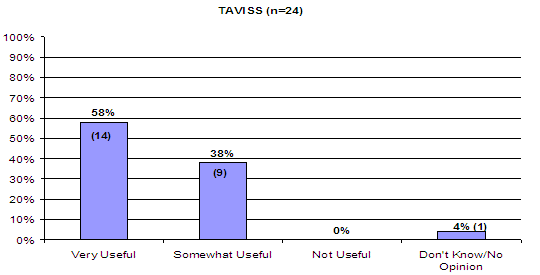
The responses regarding the usefulness of TAVISS were grouped into 3 categories: 1) provides agency contacts; 2) overall positive comment; and 3) JSI had little knowledge of TAVISS.
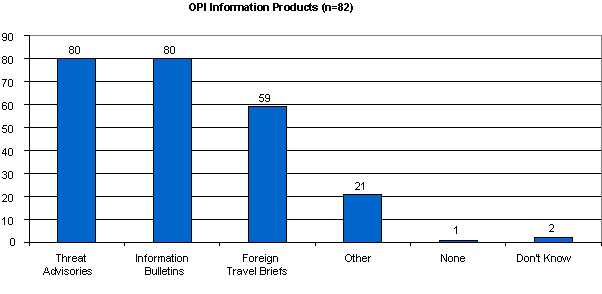
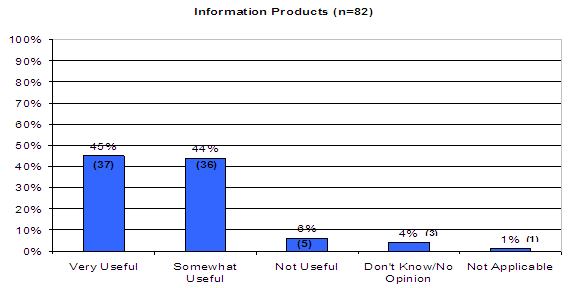
The responses regarding the usefulness of the information products were grouped into 11 categories. The top five response categories were 1) overburden by amount of information provided by OPI; 2) information provided was not specific enough; 3) overall positive comment about the information products; 4) information serves as an alert to them; and 5) use information to keep judges and court family informed.
JSIs identified a need in several areas that would assist them in protecting the judiciary. The responses were grouped into 9 categories and the top five response categories are: 1) nothing – overall positive comment about OPI; 2) summaries of threat information; 3) training (primarily on threat investigations); 4) more communication with districts; and 5) regionally focused bulletins, advisories, and local intelligence.
The responses were grouped into 10 categories and the top five were: 1) no additional information provided to OPI; 2) information on high threat trials and courthouse incidents; 3) information on terrorist groups; 4) suspicious activity, subjects, and packages; and 5) other (i.e., background information).
Threat Investigations
The responses to this question ranged from 0 to 100. On average, there were 7 open threat investigations per district.
JSIs stated that they had good relationships with state and local law enforcement and state courts. Many participated on local task forces, conducted security seminars for state judges, or served a liaison for legal associations (e.g, ABA) in the area.
| Response Choices | Number of Responses |
Percentage |
|---|---|---|
| Yes | 30 | 37 |
| No | 40 | 49 |
| Don’t Know | 12 | 14 |
| Total | 82 | 100% |
| Response Choices | Number of Responses |
Percentage |
|---|---|---|
| Yes | 48 | 58 |
| No | 22 | 27 |
| Don’t Know | 12 | 15 |
| Total | 82 | 100% |
| Response Choices | Number of Responses |
Percentage |
|---|---|---|
| Yes | 43 | 52 |
| No | 17 | 21 |
| Don’t Know | 22 | 27 |
| Total | 82 | 100% |
| Response Choices | Number of Responses |
Percentage |
|---|---|---|
| Yes | 34 | 42 |
| No | 25 | 31 |
| Don’t Know | 23 | 27 |
| Total | 82 | 100% |
| Response Choices | Number of Responses |
Percentage |
|---|---|---|
| JSI | 13 | 16 |
| DTI | 65 | 79 |
| Don’t Know | 1 | 1 |
| Other | 3 | 4 |
| Total | 82 | 100% |
| Response Choices | Number of Responses |
Percentage |
|---|---|---|
| 75% or more | 63 | 77 |
| 50-75% | 5 | 6 |
| Between 25 and 50% | 4 | 5 |
| 25% or less | 2 | 2 |
| Don’t Know | 8 | 10 |
| Total | 82 | 100% |
| Response Choices | Number of Responses |
Percentage |
|---|---|---|
| Staff workload | 21 | 25 |
| Perceived severity of threat | 41 | 50 |
| Date threat was reported to USMS | 6 | 7 |
| Don’t Know | 10 | 12 |
| Other | 4 | 5 |
| Total | 82 | 100% |
Director’s Initiatives

| Response Choices | Number of Responses |
Percentage |
|---|---|---|
| US Marshal | 1 | 1 |
| Chief DUSM | 13 | 15 |
| Supervisory DUSM | 2 | 3 |
| JSI | 50 | 61 |
| DTI | 9 | 11 |
| Don't Know | 5 | 6 |
| Other | 2 | 3 |
| Total | 82 | 100% |
| Response Choices | Number of Responses |
Percentage |
|---|---|---|
| Yes | 24 | 29 |
| No | 54 | 66 |
| Don’t Know | 4 | 5 |
| Total | 82 | 100% |
| Response Choices | Number of Responses |
Percentage |
|---|---|---|
| Not aware of TOG capabilities | 2 | 4 |
| No need for TOG assistance | 50 | 92 |
| Not aware of TOG availability | 0 | 0 |
| Other | 2 | 4 |
| Total | 54 | 100% |
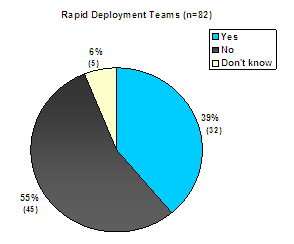
| Response Choices | Number of Responses |
Percentage |
|---|---|---|
| US Marshal | 2 | 3 |
| Chief DUSM | 32 | 39 |
| Supervisory DUSM | 1 | 1 |
| JSI | 35 | 43 |
| Don't Know | 12 | 14 |
| Other | 0 | 0 |
| Total | 82 | 100% |
| Response Choices | Number of Responses |
Percentage |
|---|---|---|
| Yes | 1 | 1 |
| No | 79 | 97 |
| Don’t Know | 2 | 2 |
| Total | 82 | 100% |
| Response Choices | Number of Responses |
Percentage |
|---|---|---|
| Not aware of RDT capabilities | 3 | 4 |
| Not aware of RDT availability | 23 | 29 |
| No need for RDT assistance | 51 | 64 |
| Other | 2 | 3 |
| Total | 79 | 100% |
FBI Joint Terrorism Task Force (JTTF)
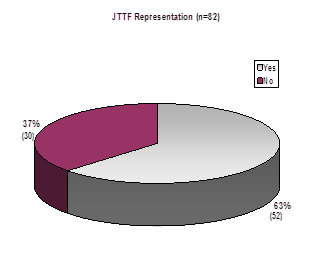
| Response Choices | Number of Responses |
Percentage |
|---|---|---|
| Full-time | 18 | 35 |
| Part-time | 31 | 59 |
| Don't Know | 3 | 6 |
| Total | 52 | 100% |
| Response Choices | Number of Responses |
Percentage |
|---|---|---|
| Daily | 26 | 50 |
| Weekly | 12 | 23 |
| Less than once a month | 3 | 6 |
| Monthly | 4 | 8 |
| None | 7 | 13 |
| Total | 52 | 100% |
| Response Choices | Number of Responses |
Percentage |
|---|---|---|
| Not Useful | 7 | 13 |
| Somewhat Useful | 13 | 25 |
| Very Useful | 22 | 43 |
| Don't Know/No opinion | 10 | 19 |
| Total | 52 | 100% |
| Response Choices | Number of Responses |
Percentage |
|---|---|---|
| Not Useful | 2 | 4 |
| Somewhat Useful | 13 | 25 |
| Very Useful | 28 | 54 |
| Don't Know/No opinion | 9 | 17 |
| Total | 52 | 100% |